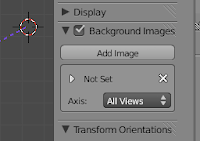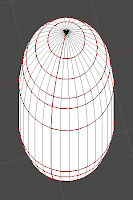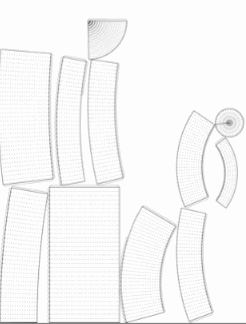Up and Down-ness
We live in a basically 2 dimensional world (if you scale movement through the air with the actual size of the earth's surface, you'll see what I mean). Not surprisingly our design for spaceships shows this two dimensionality. This isn't to say that the representation of a strict up and down in micro-gravity is universal, just very common.
"It's a trap!"
In
Star Trek 2, Spock makes a comment about saying,
"he is intelligent, but not experienced. His pattern indicates two-dimensional thinking. ." It illustrates how we are mostly experienced with 2 dimensional patterns. People still think in terms of a Mercator-like concept of east-west, north south, coordinate systems. It is sometimes a surprise to note that the shortest distance between Seattle and Tokyo is actually via Alaska.
This flat type of thinking and experience influences our imagery of what these ships and environments would look like. A classic example is the space battle in
Return of the Jedi. As we recall, the rebel fleet is approaching the
Death Star in orbit around
Endor from hyperspace. As the fleet pops out into real space we see the fleet approaching the
Death Star in perfect up/down orientation.
Rebels approach Endor aligned with Death Star, veer off, and consequently aligned with Imperial Fleet, apparently on the same plane
So we expect that a fleet that jumps in from any point in space, reappears perfectly aligned on their target, carries out an emergency maneuver to again be perfectly aligned with their next target? Not really, but it is probably understandable that if the imagery were more explicably at odd angles, it would take longer for the audience to understand what is going on. Also, films are panoramic, showing widths preferably over heights, so the subjects need to spread out along widths just to fill the frame and not radially along any direction. There is also perhaps a prejudice to photograph the cavalry charge, with all its drama. Watching the battle scenes from
DS9's "
Sacrifice of Angels" it's no surprise that with all the references to the "Charge of the Light Brigade" the climatic scene is indeed a charge from the dynamic right to the fortress enemy on the left (while the battle scenes are like Errol Flynn's
Charge of the Light Brigade, they reminded me more of Bondarchuk's
Waterloo french cavalry charge.)
Still, it's not impossible to do this differently. Some of the battle sequences in episodes of the new
Battlestar Galactica and
Babylon 5 do sometimes have assaults at odd angles adding to the confused nature of such types of battles (or any kind of battle really). It is also something that with the advent of first person space battle video games we are coming to expect visually.
Horizontal Design
While the horizontal flight of ships within fleets and orbits is really only noticeable because the ships themselves have a rather familiar sort of up and down design as well; by which I mean perpendicular to the direction of travel like an airplane or a ship.
Some of the earliest form of fictional manned rockets have the decks aligned with the direction of travel. One of the first realistic designs was from the Russian pioneer Konstantin Tsiolkovsky. Aware of the forces of acceleration, he aligned the decks with the direction of travel.
Tsiolkovsky's rocket places passenger spaces on the nose of the rockets, with the decks stacked along the direction of travel.
It is a design that makes practical sense given the forces involved. Einstein himself noted that for practical purposes there is no difference between a gravitational field and a ship undergoing acceleration. Such designs for ships also include things such as handholds and magnetic shoes for support from walls and ceilings once the engines are off.
Passenger transport at the end of the 19th century consisted of wagons, train cars, and ships. All these vehicles naturally have their decks arranged perpendicular to the direction of travel. Eventually passenger aircraft also followed similar deck arrangements. While in all of these vehicles vertical movement is not unexpected (some more than others), it is not expected to be dominant (in which case you are often in serious trouble). The most important force for the passenger would be is gravity itself.
This deck arrangement is a very strong design element and dominant in most SF ship artwork out side of the post World War II period (excepted then perhaps because of the dominant example model being V-2s). Not counting ships that actually make landfall, where deck alignment with respect to landing position makes sense, some famous (admittedly film) spaceships that follow deck layouts perpendicular to the direction of travel are: All of Star Trek's starships, Battlestar Galactica, Star Wars (Star Destroyers, Rebel Star Cruisers and frigates), Roger Young (Starship Troopers), most Babylon 5 ships and on and on etc. and so forth. A great web page to compare spaceships by their direction of motion (left to right) and deck arrangement (by window rows) is
Jeff Russell's Starship Dimensions.
There are some notable exceptions. Perhaps the most common occur in post war SF pulp covers and movies where the ships were mostly V2 variants. The Mars ship (
featured in this post) in
Conquest of Space is neat in that it goes from free-fall in orbit, to acceleration along the length, to horizontal, and back to vertical and the design accounts for all states. Another memorable exception in film are the ships in Kubrick's
2001:a space odyssey. While Kubrick's
Discovery does show some of the standard up/down decks, their placements are Escher-like (see
image), with the Bridge windows being located apparently on the ceiling and crew members standing in odd directions or spun, and of course the centrifuge where down is out and up is towards the center.
An interesting realistic design to allow for both artificial gravity and adjustment when under acceleration of the ship was created for a
plastic model kit called the "
Pilgrim Observer" space station. Designed by a NASA engineer, it was proposed as a possible upper stage for a Saturn V. The idea is to equip the ship with gimbaled arms containing the living quarters. The arms are folded in for launch and then swing out to 90° when not under acceleration. If engines are operated, the arms can swing back to maintain the apparent "g" force perpendicular to the decks. Similar designs have been proposed for Mars missions.
Up and Down...really
On the other hand, it is perhaps a bit too easy to criticize this aspect of most SF design. Particularly in the case of film, because ultimately it can only be filmed on earth and it's a lot easier (and cheaper) to walk people from scene to scene down a hall rather than float them there. So, if a ship has artificial gravity and
momentum compensators (of something like it), standard decks are just fine. The late
Defying Gravity had the interesting gimmick that their hair and clothing were sprayed down with magnetic particles to give it that 1G look.
Another thing is that a sense of up and down is perhaps more necessary than we may think. At the very least, we need some form of coordinate system to navigate about our space. Difficulty in navigation in space stations has been documented, in particular during emergency situations where relayed directions were required or navigation in areas with few navigational cues took place (
Charles Oman, Human Visual Orientation in Weightlessness, in Levels of Perception, L. Harris & M. Jenkin ed., Springer Verlag, 2003, pp. 375-398). Look closely at the hatches of the modules on the ISS pictured below. Yes they are in free-fall, but there is a definitive orientation to the station. Note the stickers denoting
Overhead,
Deck,
Port, and
Starboard. The last two are particularly odd given that it doesn't really have a propulsive motion (i.e. a forward direction) as such, but I suspect it needs a forward and an aft as well just to make it simpler to find stuff (
Monty Python fans may recall a short skit based on how to give directions for finding the claret during the
History of Ballooning episode).
Another issue is our own needs for a consistent up and down-ness. While recently listening to
Mary Roach's "Packing for Mars" I learned about a space sickness phenomenon called "
Visual Reorientation Illusion" or VRI. VRI results from the sudden 180 degree shift in perception of what is up and down. It appears to be triggered by spaces that lack a definitive floor or ceiling, or by seeing a fellow crewmember upside down and can result in a sudden onset of nausea. The recommended treatment is for all crew (not just the affected member) to immediately take a consistent feet down position (
Oman, pg. 380)
The
Tate in Space was an art program that sought architectural proposals for an orbiting art gallery. It is interesting to note that all the entries take advantage of the lack of a specific up and down and encourage the patron to view the art from new angles so to speak. The
ETALAB's entry is perhaps the most interesting in this respect at is is designed to be dynamically shaped so what is a wall or a floor is not only relative but changeable. Given the nature of VRI, I suggest these orbiting museums provide plenty of little bags.
The very idea of not having an up, or at least a changeable idea of up is itself emotive of space travel. It's perhaps the reason that Kubrick couldn't give up that chance to point out that in space what is up and down is relative, even if it made the ship's internal arrangement more mysterious. I think that mystery was the point.
 Starship modeler forum poster Justin "Bluesman" Miller posted a couple of contemporary airline profiles (posted with permission)
Starship modeler forum poster Justin "Bluesman" Miller posted a couple of contemporary airline profiles (posted with permission) In spite of some apprehensive remarks about budget spaceflight by
In spite of some apprehensive remarks about budget spaceflight by 














































